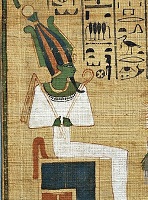 Osiris is assumed to have been a god of fertility originally; he had to ensure a good harvest and because of this he was related to the Nile inundation. However, in the modern world he is usually associated with the afterlife (both death and resurrection).
Osiris is assumed to have been a god of fertility originally; he had to ensure a good harvest and because of this he was related to the Nile inundation. However, in the modern world he is usually associated with the afterlife (both death and resurrection).
It is difficult to obtain a coherent picture about Osiris from Egyptian sources. Information is scattered. In all ages of Egyptian history (starting with the Old Kingdom Pyramid Texts) and on all kinds of monuments (stelae, papyri as well as temple and tomb walls) one can find fragments of the story. It is possible to reconstruct the main moments of the myth from these fragments, but a more coherent picture is not to be found any earlier than in the writings of the Greek authors Diodorus Siculus (1st century BC) and Plutarch (1st – 2nd century CE).
The latter informs us that Osiris was a mortal king. His brother Seth was jealous because Osiris was such a good king, and decided to kill him. He secretly took Osiris’s measurements and made a chest of exactly his size. Then he announced to the gods that he would give the chest to the god who would fit into it perfectly. When Osiris got into it Seth locked it and threw it into the Nile. Then the chest floated to Byblos on the Phoenician coast. Isis, his wife, searching for the remains of Osiris, found it there, embedded in a tree which had grown over the chest and which was holding up the roof of a palace. She used a magic spell to bring Osiris back to life, if only temporarily, long enough to impregnate her with Horus. Isis then buried her husband in the Egyptian desert. Seth discovered this and cut the body of Osiris into fourteen pieces which he scattered throughout Egypt. Isis searched for all these parts and buried each in the district where she found it. Osiris subsequently became the god of the underworld.
Diodorus Siculus told a different version of the myth, in which Osiris was a king who brought civilisation, including agriculture. When Typhon (the Greek association with Seth) murdered his brother Osiris, he divided his body into twenty six parts and distributed these among a group of conspirators. Typhon was then killed by Isis and Horus, after which Isis buried all the parts of Osiris, making replicas of them which she distributed to important places in Egypt; these became centres for the worship of Osiris.
In the Old Kingdom the living king was always identified with Horus, the son of Osiris; at his death he became identified with Osiris, and his son would become Horus. Originally this seems to have been the prerogative of royals, but soon afterwards every deceased person hoped to become an Osiris, as can be seen in the Middle Kingdom Coffin Texts and the New Kingdom Book of the Dead. Is was customary to add "The Osiris" before the name of the deceased.
The most important cult centre for Osiris was in Abydos, where according to tradition the head of Osiris was buried. Here an annual festival took place. During this (a statue of) the god was carried in a bark and the enemies of Osiris were overthrown. The tomb of the protodynastic king Djer in Abydos was believed to be the tomb of Osiris and was therefore the destination of many pilgrimages. Osiris was also worshipped in other places where parts of his body were believed to have been buried, such as Busiris in the Delta, which was associated with his backbone.
Osiris was associated with other gods, like Sokar, the funerary deity of Saqqara and Memphis, and through him with Ptah, which led to the god Ptah-Sokar-Osiris. Another god with whom Osiris was identified was Khenty-Imentyu, the original god of Abydos; his name means "Foremost of the Westerners", an indication that he was considered king in the realm of the dead. Osiris is also often called Wenennefer.
Osiris is invariably depicted as a man with a mummified body, whose head and hands are visible. He always wears a crown, usually the so-called Atef-crown (the white crown of Upper Egypt with a feather on either side, to which a ram’s horn is often added) and holds the crook and flail, signs of divine authority. Sometimes his skin is green (green being the colour of vegetation, fertility and rebirth).
Osiris was the son of Geb and Nut in the Heliopolitan Ennead. He was the brother of Isis, Nephthys and Seth, and the father of Horus.
